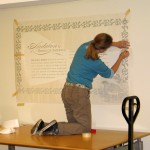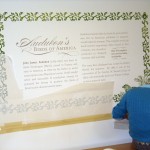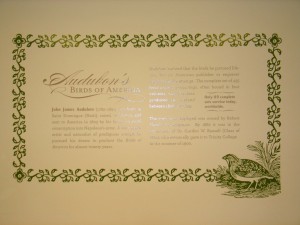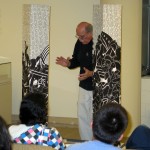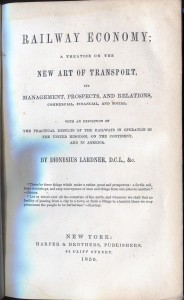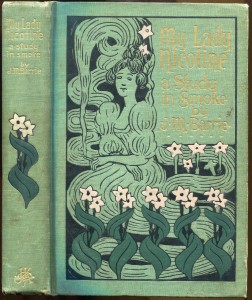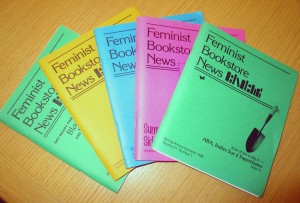 This new acquisition is cool on so many levels. I love the binding–so striking–and the fact that it’s an early science fiction novel by John Jacob Astor IV (1864-1912). Astor was 47 when he went down with the Titanic, although his 18-year-old bride and her unborn son survived.
This new acquisition is cool on so many levels. I love the binding–so striking–and the fact that it’s an early science fiction novel by John Jacob Astor IV (1864-1912). Astor was 47 when he went down with the Titanic, although his 18-year-old bride and her unborn son survived.
A Journey in Other Worlds: A Romance of the Future was published in 1894 in New York. This is early “steampunk,” a century before it became a genre.
The novel is set in the year 2088, and explores three utopias–a Christian heaven on Saturn, and Eden-like new world on Jupiter, and a technologically oriented, entrepreneur’s paradise on Earth. Space travel is possible through “apergy,” a kind of anti-gravity.
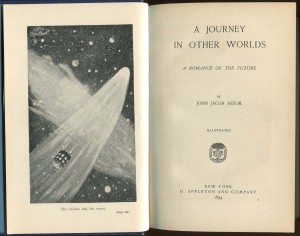 One of the most intriguing chapters is “professor Cortland’s historical sketch of the world in AD 2000.” Remember, this is 1894, twenty years before the start of World War I, and only 30 years after the Civil War. Astor’s professor interestingly gets the population right–300 million–but the U.S. now includes all of Canada, Mexico, and Central and South America, in ultimate fulfillment of the Monroe Doctrine. Here’s an excerpt (pp. 39-40):
One of the most intriguing chapters is “professor Cortland’s historical sketch of the world in AD 2000.” Remember, this is 1894, twenty years before the start of World War I, and only 30 years after the Civil War. Astor’s professor interestingly gets the population right–300 million–but the U.S. now includes all of Canada, Mexico, and Central and South America, in ultimate fulfillment of the Monroe Doctrine. Here’s an excerpt (pp. 39-40):
“Gradually the different states of Canada–or provinces, as they were then called–came to realize that their future would be far grander and more glorious in union with the United States than separated from it; and also that their sympathy was far stronger for their nearest neighbors than for anyone else. One by one these Northern States made known their desire for consolidation with the Union, retaining complete control of their local affairs, as have the older States. They were gladly welcomed by our government and people, and possible rivals became the best of friends. Preceding and also following this, the States of Mexico, Central America, and parts of South America, tiring of the incessant revolutions and difficulties among themselves, which had pretty constantly looked upon us as a big brother on account of our maintenance of the Monroe doctrine, began to agitate for annexation, knowing they would retain control of their local affairs. In this they were vigorously supported by the American residents and property-holders, who knew that their possessions would double in value the day the United States Constitution was signed. Thus . . . the Union has increased enormously in power, till it now embraces 10,000,000 square miles [the land area of the Western Hemisphere is roughly 16 million square miles], and has a free and enlightened population of 300,000,000 [the population of the Western Hemisphere is about 860 million] . . . and as a result of modern improvements, it is less of a journey now to go from Alaska to the Orinoco than it was for the Father of his Country to travel from New York or Philadelphia to the site of the city named in his honour.”
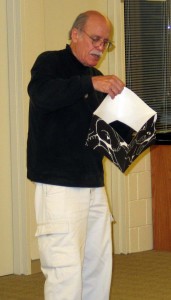 Printmaker and artist Werner Pfeiffer visited the Watkinson last night to speak to students in Erin Valentino’s First Year Seminar on post-9/11 art and Jonathan Elukin’s History of the Book course.
Printmaker and artist Werner Pfeiffer visited the Watkinson last night to speak to students in Erin Valentino’s First Year Seminar on post-9/11 art and Jonathan Elukin’s History of the Book course.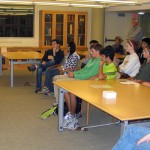 Werner constructed his work entitled “Out of the sky” as he spoke about where he was on 9/11 (crossing a bridge into Manhattan–he saw the second plane hit) and how the project took shape in his mind and through his hands over the next five years.
Werner constructed his work entitled “Out of the sky” as he spoke about where he was on 9/11 (crossing a bridge into Manhattan–he saw the second plane hit) and how the project took shape in his mind and through his hands over the next five years.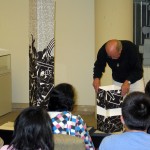 The towers, depicting names of the the victims and images of falling bodies, girders, and steps, are made up of 36 prints carved into 18 blocks of wood–blocks that Werner carved himself, a relief process that involves cutting away what one does not wish to see in the print.
The towers, depicting names of the the victims and images of falling bodies, girders, and steps, are made up of 36 prints carved into 18 blocks of wood–blocks that Werner carved himself, a relief process that involves cutting away what one does not wish to see in the print.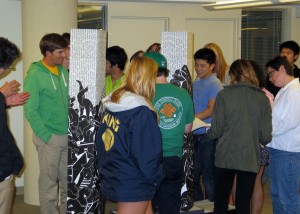 Werner always designs hands-on productions, and he encouraged the students to handle the towers, and even help take them down.
Werner always designs hands-on productions, and he encouraged the students to handle the towers, and even help take them down.